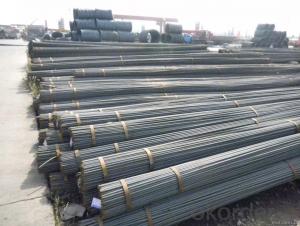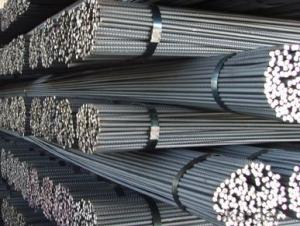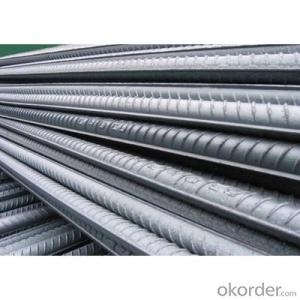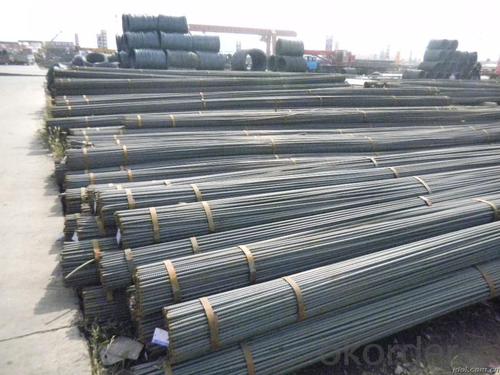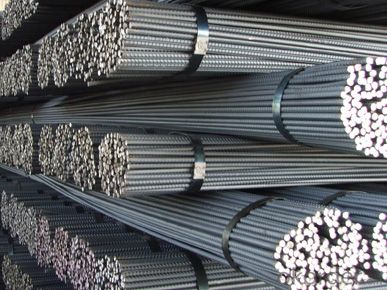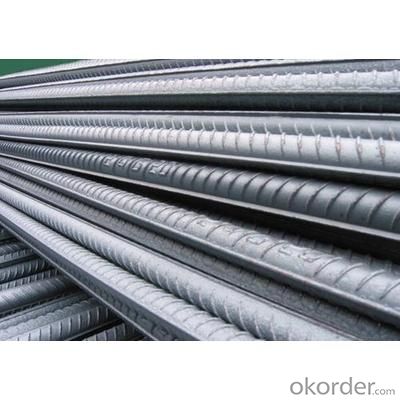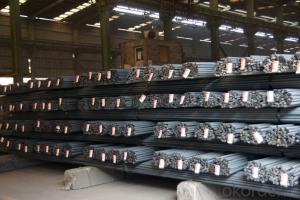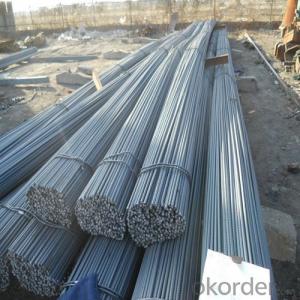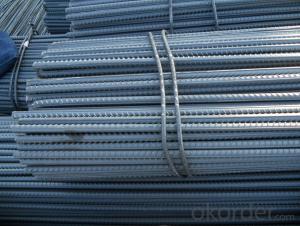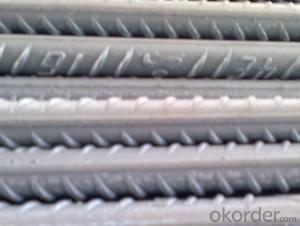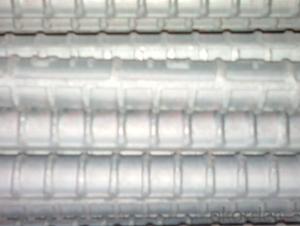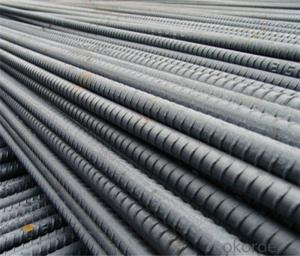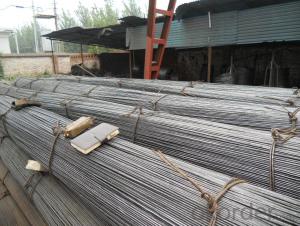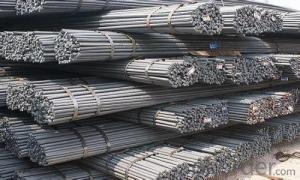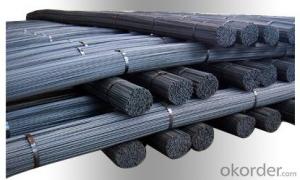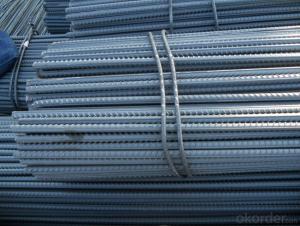ASTM GR60 deformed steel bar for construction
- Loading Port:
- Tianjin
- Payment Terms:
- TT or LC
- Min Order Qty:
- 25 m.t.
- Supply Capability:
- 100000 m.t./month
OKorder Service Pledge
OKorder Financial Service
You Might Also Like
Product Description:
OKorder is offering ASTM GR60 deformed steel bar for construction at great prices with worldwide shipping. Our supplier is a world-class manufacturer of steel, with our products utilized the world over. OKorder annually supplies products to European, North American and Asian markets. We provide quotations within 24 hours of receiving an inquiry and guarantee competitive prices.
Product Applications:
ASTM GR60 deformed steel bar are ideal for structural applications and are widely used in the construction of buildings and bridges, and the manufacturing, petrochemical, and transportation industries.
Product Advantages:
OKorder's deformed steel bar are durable, strong, and resist corrosion.
Main Product Features:
· Premium quality
· Prompt delivery & seaworthy packing (30 days after receiving deposit)
· Corrosion resistance
· Can be recycled and reused
· Mill test certification
· Professional Service
· Competitive pricing
Product Specifications:
| Minimum Order Quantity: | Unit: | m.t. | Loading Port: | ||
| Supply Ability: | Payment Terms: | Package: | wire rod packing |
Product Description:
Product Description:
Chemical Composition: (Please kindly find our chemistry of our material based on HRB500 as below for your information)
Grade | Technical data of the original chemical composition (%) | ||||||
C | Mn | Si | S | P | V | ||
HRB400 | ≤0.25 | ≤1.60 | ≤0.80 | ≤0.045 | ≤0.045 | 0.04-0.12 | |
Physical capability | |||||||
Yield Strength (N/cm²) | Tensile Strength (N/cm²) | Elongation (%) | |||||
≥400 | ≥570 | ≥14 | |||||
Theoretical weight and section area of each diameter as below for your information:
Diameter(mm) | Section area (mm²) | Mass(kg/m) | Weight of 12m bar(kg) |
6 | 28.27 | 0.222 | 2.664 |
8 | 50.27 | 0.395 | 4.74 |
10 | 78.54 | 0.617 | 7.404 |
12 | 113.1 | 0.888 | 10.656 |
14 | 153.9 | 1.21 | 14.52 |
16 | 201.1 | 1.58 | 18.96 |
18 | 254.5 | 2.00 | 24 |
20 | 314.2 | 2.47 | 29.64 |
22 | 380.1 | 2.98 | 35.76 |
25 | 490.9 | 3.85 | 46.2 |
28 | 615.8 | 4.83 | 57.96 |
32 | 804.2 | 6.31 | 75.72 |
36 | 1018 | 7.99 | 98.88 |
40 | 1257 | 9.87 | 118.44 |
50 | 1964 | 15.42 | 185.04 |
Usage and Applications of HRB400 Deformed Steel Bar:
Deformed bar is widely used in buildings, bridges, roads and other engineering construction. Big to highways, railways, bridges, culverts, tunnels, public facilities such as flood control, dam, small to housing construction, beam, column, wall and the foundation of the plate, deformed bar is an integral structure material. With the development of world economy and the vigorous development of infrastructure construction, real estate, the demand for deformed bar will be larger and larger..
Packaging & Delivery of HRB400 Deformed Steel Bar:
Packaging Detail: products are packed in bundle and then shipped by container or bulk vessel, deformed bar is usually naked strapping delivery, when storing, please pay attention to moisture proof. The performance of rust will produce adverse effect.
Each bundle weight: 2-3MT, or as required
Payment term: TT or L/C
Delivery Detail: within 45 days after received advanced payment or LC.
Label: to be specified by customer, generally, each bundle has 1-2 labels
Trade terms: FOB, CFR, CIF
FAQ:
Q1: Why buy Materials & Equipment from OKorder.com?
A1: All products offered byOKorder.com are carefully selected from China's most reliable manufacturing enterprises. Through its ISO certifications, OKorder.com adheres to the highest standards and a commitment to supply chain safety and customer satisfaction.
Q4: What makes stainless steel stainless?
A4: Stainless steel must contain at least 10.5 % chromium. It is this element that reacts with the oxygen in the air to form a complex chrome-oxide surface layer that is invisible but strong enough to prevent further oxygen from "staining" (rusting) the surface. Higher levels of chromium and the addition of other alloying elements such as nickel and molybdenum enhance this surface layer and improve the corrosion resistance of the stainless material.
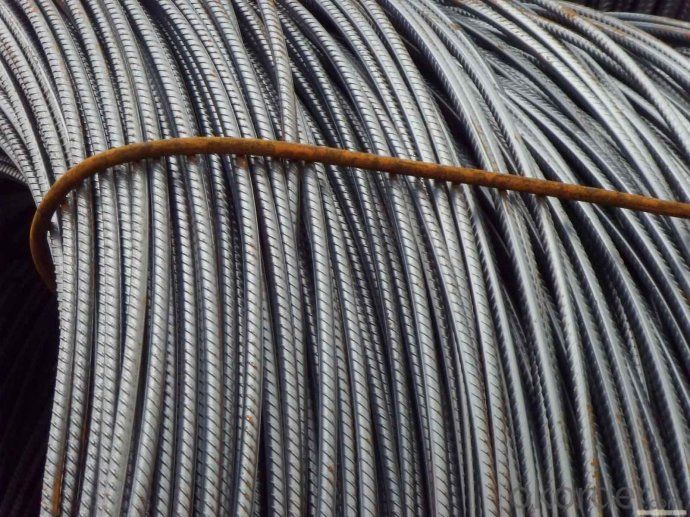
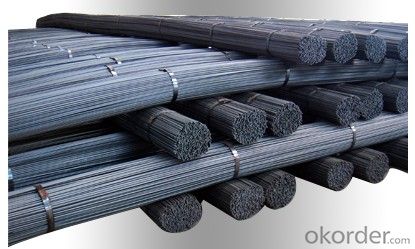
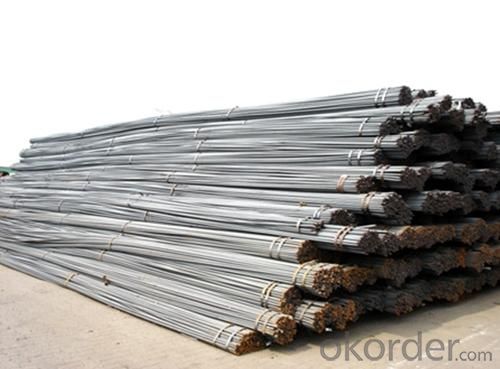
- Q: Are steel rebars suitable for use in seismic zones?
- Steel rebars are indeed appropriate for use in seismic zones. Due to their exceptional strength and ductility properties, steel rebars are widely employed in construction projects within seismic zones. In the event of an earthquake, buildings and structures are subjected to considerable stress and movement. Thankfully, steel rebars step in to fortify the concrete and offer additional strength and flexibility. This, in turn, allows for the absorption and dispersion of the energy produced during seismic events, effectively diminishing the likelihood of structural damage or collapse. Moreover, steel rebars boast resistance to corrosion, a vital characteristic in regions prone to seismic activity, as the reinforcement must maintain its integrity over time. All in all, the utilization of steel rebars in seismic zones proves to be a highly effective means of augmenting the safety and longevity of structures situated in such precarious areas.
- Q: Are steel rebars suitable for use in high-temperature applications?
- High-temperature applications are generally not suitable for the use of steel rebars. Despite being a strong and durable material, steel has limitations when exposed to high temperatures. It can undergo a significant reduction in strength and even a loss of structural integrity, leading to potential failures. When subjected to high temperatures, steel goes through a process known as thermal expansion, which can weaken and deform it. This phenomenon is particularly noticeable in rebars, which are commonly used to reinforce concrete structures. The high temperatures cause the rebars to expand, exerting excessive pressure on the surrounding concrete. This pressure can result in cracks and potentially compromise the stability of the structure. Furthermore, prolonged exposure to high temperatures can cause a loss of the steel's mechanical properties, including its tensile strength and load-bearing capacity. As a result, the rebars become less effective in resisting external forces and reinforcing the concrete. For this reason, it is generally recommended to consider alternative materials, such as stainless steel or special alloys, for high-temperature applications. These materials are specifically designed to withstand elevated temperatures without compromising their structural integrity. To ensure safety and structural stability, it is important to consult with experts and engineers who are familiar with high-temperature applications in order to determine the most suitable materials for specific projects.
- Q: Are steel rebars suitable for use in structures with high resistance to chemicals?
- No, steel rebars are not suitable for use in structures with high resistance to chemicals.
- Q: What are the different types of steel rebars used in underground constructions?
- Underground constructions commonly employ various types of steel rebars, each serving a specific purpose. These rebars fortify concrete structures, enhancing their durability and strength. 1. Carbon Steel Rebars: The most prevalent kind of rebar used underground is carbon steel rebars. They boast high tensile strength due to their composition of carbon steel, rendering them suitable for diverse applications. 2. Epoxy-Coated Rebars: Carbon steel rebars receive an epoxy coating, transforming them into epoxy-coated rebars. This protective layer makes them resistant to corrosion, rendering them ideal for underground constructions where moisture and chemicals are present. 3. Stainless Steel Rebars: Stainless steel rebars offer exceptional resistance to corrosion and possess excellent strength properties. They are commonly employed in underground constructions that anticipate extreme environmental conditions, such as high humidity or exposure to saltwater. 4. Galvanized Rebars: Carbon steel rebars undergo a zinc coating process, resulting in galvanized rebars. This coating enhances their corrosion resistance, making them suitable for underground constructions situated in areas with elevated moisture levels or exposure to chemicals. 5. Fiberglass Rebars: Fiberglass rebars consist of glass fibers embedded within a resin matrix. They are lightweight, corrosion-resistant, and possess high tensile strength. Fiberglass rebars are frequently utilized in underground constructions that necessitate non-magnetic properties, such as proximity to sensitive equipment or areas susceptible to electromagnetic interference. The selection of a specific type of steel rebar for an underground construction project is based on its unique advantages and the project's specific requirements. Factors such as environmental conditions, load-bearing capacity, and anticipated lifespan are carefully considered when determining the appropriate steel rebar for a particular application.
- Q: What are the guidelines for using steel rebars in pre-stressed or post-tensioned concrete elements?
- The guidelines for using steel rebars in pre-stressed or post-tensioned concrete elements include ensuring the rebars meet the required specifications and standards for strength, size, and corrosion resistance. They should be properly anchored and positioned within the concrete element according to the design specifications. Additionally, care should be taken to avoid damaging or stressing the rebars during the construction process, and proper curing and protection measures should be implemented to prevent corrosion and ensure the longevity of the structure.
- Q: How do steel rebars affect the thermal conductivity of a structure?
- The thermal conductivity of a structure can be greatly affected by steel rebars. Unlike other construction materials like concrete, steel has a much higher thermal conductivity. When steel rebars are embedded in concrete structures, they create an easier path for heat to flow through the structure. This increased thermal conductivity can have both positive and negative impacts. On the positive side, the presence of steel rebars allows for efficient heat transfer, which can be advantageous in certain applications. For instance, in buildings with heating or cooling systems, the steel rebars can help distribute the desired temperature more evenly throughout the structure. Nevertheless, the increased thermal conductivity can also lead to negative consequences. In buildings where thermal insulation is vital, such as those in extreme climates, the steel rebars can result in higher heat loss or gain. As a result, this can lead to increased energy consumption and higher costs for heating or cooling. To address these negative effects, various insulation techniques can be utilized to reduce heat transfer through the steel rebars. One common approach is to add insulation layers around the rebars or use materials with lower thermal conductivity in the concrete mixture. These measures can help minimize the impact of steel rebars on the overall thermal conductivity of the structure. In conclusion, steel rebars have a significant influence on the thermal conductivity of a structure. While they can enhance heat distribution in certain cases, they can also contribute to increased energy consumption and heat loss. Proper insulation techniques should be implemented to minimize these negative effects and optimize the thermal performance of the structure.
- Q: Can steel rebars be used in historical bridge restoration?
- Yes, steel rebars can be used in historical bridge restoration. Steel rebars provide strength, durability, and resistance to corrosion, making them an ideal choice for reinforcing and repairing historical bridges. However, it is important to ensure that the use of steel rebars is in line with preservation guidelines and does not compromise the historical integrity of the bridge.
- Q: Can steel rebars be used in wastewater treatment plant construction?
- Yes, steel rebars can be used in wastewater treatment plant construction. Steel rebars are commonly used in the construction of reinforced concrete structures, including wastewater treatment plants. They provide additional strength and durability to the concrete, helping it withstand the harsh conditions and corrosive environment often found in wastewater treatment facilities. The rebars are typically coated with epoxy or other corrosion-resistant materials to protect them from the corrosive effects of wastewater. Additionally, proper design and placement of the rebars ensure structural integrity and longevity of the treatment plant. Overall, steel rebars are a commonly used and effective reinforcement material in wastewater treatment plant construction.
- Q: What are the different methods of reinforcing concrete structures using steel rebars?
- There are several methods of reinforcing concrete structures using steel rebars. These include placing the rebars in a grid pattern to provide overall strength and support, using stirrups or ties to hold the rebars in place and prevent them from moving, using dowel bars to connect two separate concrete elements, and using anchor bolts or hooks to secure the rebars to the existing structure. Additionally, steel mesh or fiber reinforcement can be used to enhance the overall durability and resilience of the concrete structure.
- Q: How do steel rebars affect the overall stability of a structure?
- Steel rebars play a crucial role in enhancing the overall stability of a structure. By reinforcing concrete, rebars increase its tensile strength and prevent cracking or collapsing under heavy loads or external forces. This reinforcement allows the structure to bear more weight, withstand seismic activity, and resist deformation, ultimately ensuring its durability and safety.
Send your message to us
ASTM GR60 deformed steel bar for construction
- Loading Port:
- Tianjin
- Payment Terms:
- TT or LC
- Min Order Qty:
- 25 m.t.
- Supply Capability:
- 100000 m.t./month
OKorder Service Pledge
OKorder Financial Service
Similar products
Hot products
Hot Searches
Related keywords
